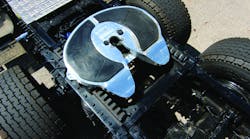The evolution of coupling systems is now moving from the first stage of cab actuated air release systems, says Rich Carroll, vice president of sales & marketing at Jost International. “We are seeing a paradigm shift that will take fifth wheel coupling systems beyond their role as reliable mechanical devices to playing a more sophisticated role within the field of ADAS [advanced driver assistance systems] technologies,” he states. “We are now seeing some early adopter fleets that have been using air release systems successfully as the first movers into sensor systems.
“There are several drivers for this that include driver demographics, aerodynamic tractor and trailer designs, and even autonomous vehicle fundamentals,” Carroll adds. “We believe that as aerodynamic designs develop, at some point it will become difficult, if not impossible, for drivers to physically reach the fifth wheel handle and to put themselves in a position to visually assure a good couple. This is what’s driving the next step in the evolution of sensor systems that communicate coupling conditions directly to the cab.”
Jost’s JSK37USK sensor coupling system, which was demonstrated this past fall, utilizes sensors to verify that the kingpin is in the lock position and that the fifth wheel is locked and the release handle secured. The lock status can be shown either by a Jost-supplied dash display or communicated through the vehicle’s CAN (controller area network) bus. Another integral component of the system will be automated connections for electrical and pneumatic systems and for the ability to retract landing gear.
SAF-Holland has introduced the ELI-te fifth wheel coupling assistant as an integrated option on new vehicles and for retrofit on Holland FW35 Series fifth wheels, says Bryan Redeker, product manager of fifth wheels. The electronic lock indicator trailer-sensing technology uses an electronic control module mounted directly to the fifth wheel top plate and remote indicators to show when a trailer kingpin is properly coupled to an ELI-te equipped fifth wheel.
With the ELI-te fifth wheel coupling assistant, high-intensity white LED lights mounted within the fifth wheel automatically illuminate the lock jaws to direct the driver’s attention to the connection between the lock jaws and kingpin. If a coupling problem is detected, daytime-visible red LED lights begin flashing from both sides.
Redeker also says that SAF-Holland continues to design fifth wheels for weight reduction. Included are the aluminum top plate 55,000-lb.-capacity FWAL, the steel top plate 50,000-lb.-capacity FW17, and the LowLube version FW16. All of these fifth wheels can be mounted on the company’s integrated ILS lightweight slider or on stationary mounts. The ILS can also be used on the FW35 Series top plates.
“The FWAL top plate can save upwards of 100 lbs. compared to a standard-duty equivalent, and the cast steel FW17 and FW16 top plates are around 30 lbs. lighter than standard-duty models,” Redeker states. “When these top plates are combined with the ILS slider, fleets like bulk carriers wanting to increase payload can realize optimum weight savings.”
The Fontaine Fifth Wheel NWB air slide is also a weight-saving design. According to the company, the NWB is 40 to 70 lbs. lighter than competitive steel slide systems. The design features a smaller footprint with steel reinforcement for strength and durability, and a new greaseless bracket liner provides consistent lubrication and reduced wear because there is no metal-to-metal contact. Fontaine also notes that lower maintenance costs with the NWB Air Slide result from a dual durometer two-piece bushing for improved shock absorption and easier service.
“Fleets and OEMs continue to seek weight savings to improve fuel economy and hauling capacity,” says Roger Crawford, president of Fontaine Fifth Wheel—North America OEM. “The innovative design of new fifth wheel products can help fleets offset the weight of heavier emissions system components and improve capacity for weight-sensitive fleets.”



